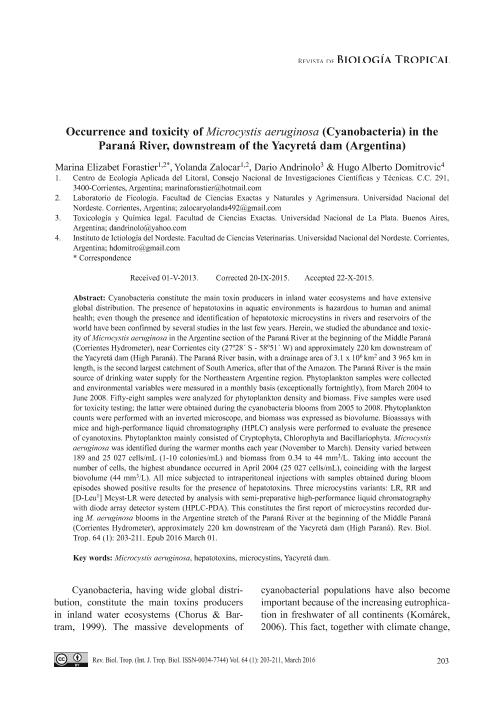Mostrar el registro sencillo del ítem
dc.contributor.author
Forastier, Marina

dc.contributor.author
Zalocar, Yolanda

dc.contributor.author
Andrinolo, Dario

dc.contributor.author
Domitrovic, Hugo Alberto

dc.date.available
2017-12-07T18:06:48Z
dc.date.issued
2016-03
dc.identifier.citation
Forastier, Marina; Zalocar, Yolanda; Andrinolo, Dario; Domitrovic, Hugo Alberto; Occurrence and toxicity of Microcystis aeruginosa (Cyanobacteria) in the Paraná River, downstream of the Yacyretá dam (Argentina); Universidad de Costa Rica; Revista de Biología Tropical; 64; 1; 3-2016; 203-211
dc.identifier.issn
0034-7744
dc.identifier.uri
http://hdl.handle.net/11336/29983
dc.description.abstract
Cyanobacteria constitute the main toxin producers in inland water ecosystems and have extensive global distribution. The presence of hepatotoxins in aquatic environments is hazardous to human and animal health; even though the presence and identification of hepatotoxic microcystins in rivers and reservoirs of the world have been confirmed by several studies in the last few years. Herein, we studied the abundance and toxicity of Microcystis aeruginosa in the Argentine section of the Paraná River at the beginning of the Middle Paraná (Corrientes Hydrometer), near Corrientes city (27º28´ S - 58º51´ W) and approximately 220 km downstream of the Yacyretá dam (High Paraná). The Paraná River basin, with a drainage area of 3.1 x 106 km2 and 3 965 km in length, is the second largest catchment of South America, after that of the Amazon. The Paraná River is the main source of drinking water supply for the Northeastern Argentine region. Phytoplankton samples were collected and environmental variables were measured in a monthly basis (exceptionally fortnightly), from March 2004 to June 2008. Fifty-eight samples were analyzed for phytoplankton density and biomass. Five samples were used for toxicity testing; the latter were obtained during the cyanobacteria blooms from 2005 to 2008. Phytoplankton counts were performed with an inverted microscope, and biomass was expressed as biovolume. Bioassays with mice and high-performance liquid chromatography (HPLC) analysis were performed to evaluate the presence of cyanotoxins. Phytoplankton mainly consisted of Cryptophyta, Chlorophyta and Bacillariophyta. Microcystis aeruginosa was identified during the warmer months each year (November to March). Density varied between 189 and 25 027 cells/mL (1-10 colonies/mL) and biomass from 0.34 to 44 mm3/L. Taking into account the number of cells, the highest abundance occurred in April 2004 (25 027 cells/mL), coinciding with the largest biovolume (44 mm3/L). All mice subjected to intraperitoneal injections with samples obtained during bloom episodes showed positive results for the presence of hepatotoxins. Three microcystins variants: LR, RR and [D-Leu1] Mcyst-LR were detected by analysis with semi-preparative high-performance liquid chromatography with diode array detector system (HPLC-PDA). This constitutes the first report of microcystins recorded during M. aeruginosa blooms in the Argentine stretch of the Paraná River at the beginning of the Middle Paraná (Corrientes Hydrometer), approximately 220 km downstream of the Yacyretá dam (High Paraná).
dc.format
application/pdf
dc.language.iso
eng
dc.publisher
Universidad de Costa Rica

dc.rights
info:eu-repo/semantics/openAccess
dc.rights.uri
https://creativecommons.org/licenses/by-nc-sa/2.5/ar/
dc.subject
Microcystis Aeruginosa
dc.subject
Hepatotoxins
dc.subject
Microcystins
dc.subject
Yacyretá Dam
dc.subject.classification
Otras Ciencias Biológicas

dc.subject.classification
Ciencias Biológicas

dc.subject.classification
CIENCIAS NATURALES Y EXACTAS

dc.title
Occurrence and toxicity of Microcystis aeruginosa (Cyanobacteria) in the Paraná River, downstream of the Yacyretá dam (Argentina)
dc.type
info:eu-repo/semantics/article
dc.type
info:ar-repo/semantics/artículo
dc.type
info:eu-repo/semantics/publishedVersion
dc.date.updated
2017-10-04T14:55:48Z
dc.identifier.eissn
2215-2075
dc.journal.volume
64
dc.journal.number
1
dc.journal.pagination
203-211
dc.journal.pais
Costa Rica

dc.journal.ciudad
Turrialba
dc.description.fil
Fil: Forastier, Marina. Consejo Nacional de Investigaciones Científicas y Técnicas. Centro Científico Tecnológico Conicet - Nordeste. Centro de Ecología Aplicada del Litoral. Universidad Nacional del Nordeste. Centro de Ecología Aplicada del Litoral; Argentina
dc.description.fil
Fil: Zalocar, Yolanda. Consejo Nacional de Investigaciones Científicas y Técnicas. Centro Científico Tecnológico Conicet - Nordeste. Centro de Ecología Aplicada del Litoral. Universidad Nacional del Nordeste. Centro de Ecología Aplicada del Litoral; Argentina
dc.description.fil
Fil: Andrinolo, Dario. Consejo Nacional de Investigaciones Científicas y Técnicas; Argentina. Universidad Nacional de La Plata. Facultad de Ciencias Exactas; Argentina
dc.description.fil
Fil: Domitrovic, Hugo Alberto. Universidad Nacional del Nordeste. Facultad de Ciencias Veterinarias; Argentina. Consejo Nacional de Investigaciones Científicas y Técnicas; Argentina
dc.journal.title
Revista de Biología Tropical

dc.relation.alternativeid
info:eu-repo/semantics/altIdentifier/doi/http://dx.doi.org/10.15517/rbt.v64i1.8993
dc.relation.alternativeid
info:eu-repo/semantics/altIdentifier/url/https://revistas.ucr.ac.cr/index.php/rbt/article/view/8993
dc.relation.alternativeid
info:eu-repo/semantics/altIdentifier/url/http://www.redalyc.org/articulo.oa?id=44943437018
Archivos asociados
